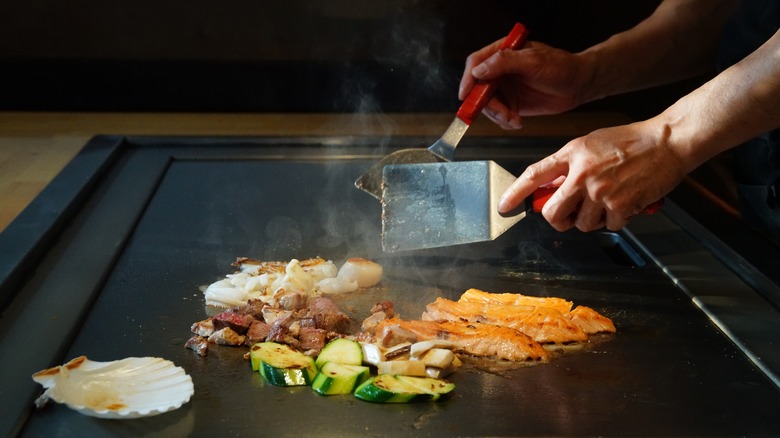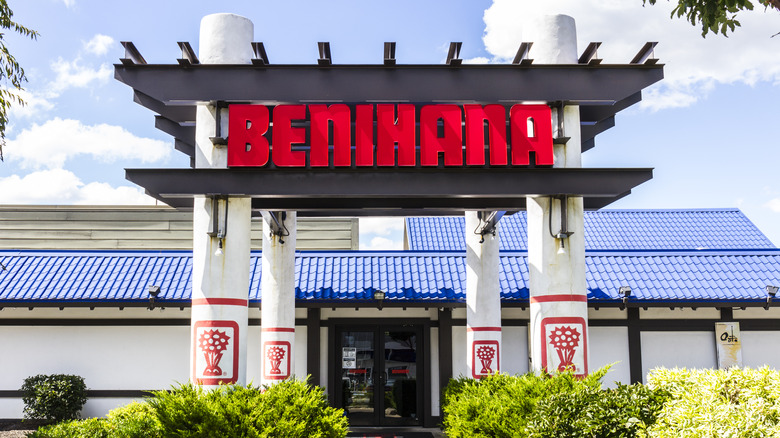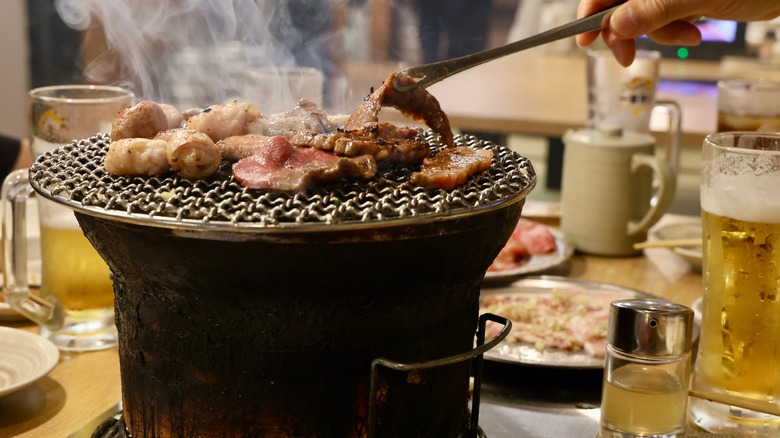The Confusing History Of Hibachi-Style Restaurants
Growing up, I used to love going to a local Japanese steakhouse on special occasions. It was unlike any other restaurant in the area — everyone sat at large tables equipped with iron griddles, and the chefs would cook your dinner right in front you, all while cracking jokes, tossing eggs into their hats, and making onion volcanoes erupt with fire.
Many Americans probably recognize this sort of dinner-and-a-show place as a hibachi-style restaurant, and they're all over the country. But their common name in North America is a misnomer: these sorts of steakhouses are actually cooking in a different style called teppanyaki.
The term hibachi, misappropriated as it is, actually refers to a different heating method that dates back to Japan's Heian period, which spanned the 8th to 12th centuries — and it wasn't chiefly used for cooking. Hibachi are pots which vary wildly in size, and their main purpose is to warm things, from a pot of tea to your frigid hands. They're heated with charcoal, and are sometimes confused with another charcoal-heated pot called a shichirin, which is used for grilling. But neither are really all that similar to the teppan: the broad, flat iron griddles which are associated with those entertaining Japanese steakhouses.
The Japanese steakhouse in America
The history of teppanyaki is actually much more recent, with estimates of its origins ranging from a couple hundred years ago to the early 20th century. Some sources even place the true birth of teppanyaki as a culinary tradition in the immediate post-World War II era, when allied soldiers were occupying Japan and hungry for grilled beef. Regardless of when rice or meat first hit teppan, one thing's for certain: Americans would likely know nothing of this style of cooking were it not for the rise of Benihana.
Founded by Hiroaki "Rocky" Aoki in Midtown Manhattan in 1964, Benihana today claims the chain was the first to introduce teppanyaki to America. Named for his parents' Tokyo coffee-shop-turned-restaurant — itself named for a safflower they found in the city after the firebombing of 1945 — the New York steakhouse was built partly on the great success of his family's business in Japan. While it struggled in its first year, a glowing review by powerful food critic Clementine Paddleford for the New York Herald Tribune catapulted Benihana to stardom. The theatricality and fancy knife work of "hibachi-style" restaurants, the onion volcanoes and egg-flipping antics, is largely modeled on Benihana and its overwhelming success in the 1960s.
Why are teppans called hibachi grills?
Despite the enduring popularity of Benihana and the many Japanese American restaurants since modeled after the teppanyaki style of cooking, many people in North America erroneously call these steakhouses "hibachi-style." There's no clear answer to how these terms got confused so thoroughly, but why it happened may have to do with the hibachi's presence in America before Benihana hit the scene.
The previously mentioned shichirin, another kind of small Japanese grill, had been known as a "hibachi" in the States for quite some time. It's easy to see why a charcoal grill with metal grates would be popular in the U.S., as it's a pretty familiar and straightforward method of cooking for Americans. But some writers speculate that the word "shichirin" was simply too hard to pronounce, which would explain why "hibachi" became the term of choice. Benihana has attempted to clear up this confusion on its website, with explainers on the differences between the terms and cooking methods, but for decades the word has stuck.


